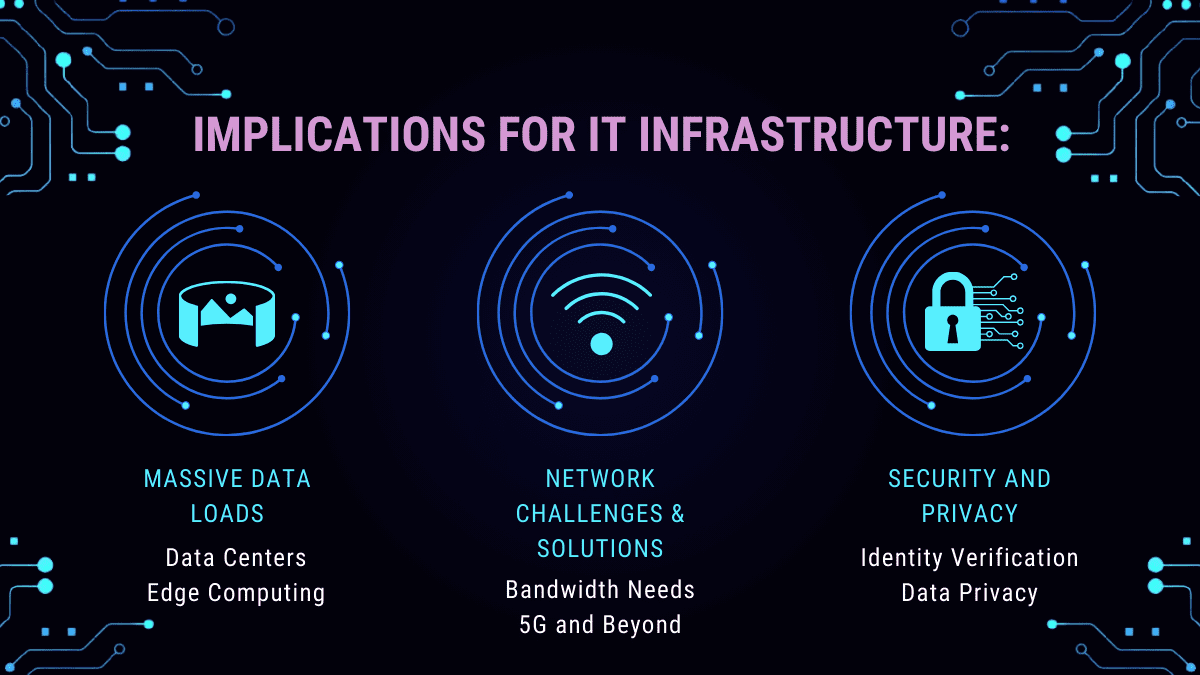
The dawn of the Metaverse—a collective virtual shared space created by the convergence of physically persistent virtual reality—is shifting paradigms in the realm of IT. This digital universe, envisaged by sci-fi enthusiasts for decades, is now rapidly becoming a reality. As we hover on the brink of a Metaverse-dominated age, it’s imperative to grasp its implications for IT infrastructure and development.
What is the Metaverse?
Before delving into the nitty-gritty of its IT implications, it’s essential to understand the Metaverse itself. Imagine an expansive digital universe where multiple 3D virtual worlds, digital twins, augmented realities, and simulations coexist. Users can interact, communicate, trade, play, and even work, all in real-time, transcending the physical constraints of reality.
Implications for IT Infrastructure:

1. Massive Data Loads:
- Data Centers: With the explosion of virtual worlds and augmented realities, there will be an astronomical increase in data. This requires robust, scalable, and energy-efficient data centers to support seamless experiences.
- Edge Computing: Proximity to users is crucial to reduce latency. Edge computing—processing data closer to the data source—will become even more critical in the Metaverse for real-time interactions.
2. Network Challenges and Solutions:
- Bandwidth Needs: High-quality virtual worlds demand vast bandwidths. Upgrading global internet infrastructure to support these needs, especially for 3D content and real-time interactions, becomes paramount.
- 5G and Beyond: Speed and reduced latency are essential for the Metaverse. 5G technology—and its successors—offer promise in delivering the necessary network capabilities.
3. Security and Privacy:
- Identity Verification: As the lines blur between the virtual and real world, ensuring the authenticity of users and assets within the Metaverse becomes vital.
- Data Privacy: Protecting personal data within a sprawling digital ecosystem necessitates advanced encryption methodologies and privacy protocols.
Implications for Software Development:
1. Demand for Interoperability:
- APIs and SDKs: For the Metaverse to function cohesively, different platforms and applications must communicate effectively. This requires the development of universal APIs and SDKs.
- Standardized Protocols: Unlike today’s fragmented digital ecosystem, the Metaverse needs standardized protocols to ensure smooth cross-platform interactions.
2. Augmented and Virtual Reality Development:
- Content Creation: Building immersive, lifelike virtual worlds calls for advancements in 3D content creation tools and software.
- Interaction Models: Traditional interaction models may not suffice. Developers need to envision new paradigms for user interactions within these expansive virtual landscapes.
3. Economic Systems and Digital Assets:
- Blockchain and NFTs: Ownership and trade of digital assets within the Metaverse might rely heavily on blockchain technology and Non-Fungible Tokens (NFTs) to ensure authenticity and security.
4. AI and Machine Learning:
- Personalized Experiences: To enhance user engagement, AI could be harnessed to create personalized narratives and experiences within the Metaverse.
- Natural Language Processing (NLP): For seamless communication between avatars and AI entities, advanced NLP systems will be essential.
Conclusion:
The Metaverse, with its promise of a cohesive digital universe, is no longer the stuff of fiction. As its horizon broadens, the challenges it poses to IT infrastructure and software development become more apparent. However, with these challenges come unprecedented opportunities. The IT realm is poised for transformation, and those ready to adapt and innovate will shape the future of this virtual frontier.










